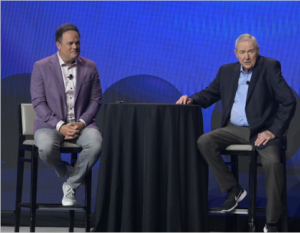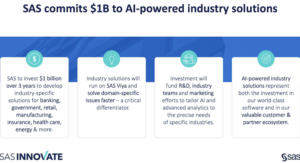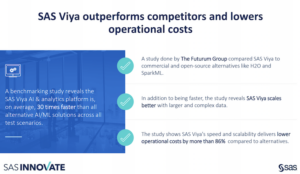
SAS Innovate Conference Showcases Investments, Partnerships, and Benchmarks

(JHVEPhoto/Shutterstock)
The SAS Innovate conference drew a global crowd this week in Orlando. The analytics pioneer unveiled new R&D investment plans, new and continued partnerships and integrations, and a benchmarking study that explored the performance, scalability, and costs of its SAS Viya AI and analytics platform.
A main theme of the event was reducing costs and inefficiencies to optimize business: “Over the last few years, we have been tested in unexpected ways, from a pandemic, distrust in supply chains, workforce shortages, financial instability in the banking sector. And through that experience, we gained a new appreciation for resilience. We saw firsthand the importance of operating with speed and agility. Organizations need technology that allows them to make the most of the data, models and workforce they have,” said SAS CEO Jim Goodnight during the opening session.
Investing $1 Billion in Analytics
The company announced it will invest $1 billion over the next three years to continue developing advanced analytics solutions for specific industries including banking, government, insurance, healthcare, and retail. These solutions will run on SAS Viya, the company’s cloud-native, massively parallel AI and analytics platform.

SAS CTO Bryan Harris chats with CEO Jim Goodnight on stage at SAS Innovate in Orlando. (Source: SAS)
The latest investment builds on a previous $1 billion investment in 2019 and includes direct R&D and industry marketing. The industry solutions will enable data scientists, statisticians, and business analysts to leverage AI, machine learning, and analytics for use cases like fraud detection, public health and safety measures, enhanced patient care, and manufacturing optimization.
“The billion-dollar investment in our solutions is really about how we support the incredible work for our data scientists, statisticians, and developers who are actively working with industry experts like consultants, system engineers, cloud architects, marketing, and others. It’s about bringing the whole package together so that our customers get the benefit of our investment to help them reduce time to value for our software,” said CTO Bryan Harris in a press conference at the event.
Expanding Partnerships
The company featured new and continued partnerships and integrations during the conference.
“SAS is partnering differently than we ever have before with technology companies that complement our core AI and analytic capabilities. And for us, it’s about two companies working together to deliver the right capabilities for our customers, on our research dollars, not in the middle of a contract with the customer. It’s about us working proactively getting the integrations right and delivering incredible outcomes from those two technologies coming together,” Harris said during the press conference.
SAS says its partners will play a key role in the rollout of its latest industry-specific solutions. One example partner is Microsoft. SAS Viya on Microsoft Azure will include Azure confidential computing capabilities thanks to AMD EPYC processors with secure encrypted virtualization technology.
In an interview with Datanami, CTO Harris said this partnership came about when SAS noticed a large intersection between its customer base and Microsoft’s cloud customers, particularly in the financial services industry.
“One of the biggest risks of moving from on-prem to the cloud is this fear of compromised data, unencrypted data, especially in that space,” said Harris. “So, Azure confidential computing allows data to be completely encrypted all the way. For the rare moment you have to unencrypt and compute something, it decrypts and calculates and then re-encrypts.”
The new confidential computing capabilities will soon be available in the U.S., the Netherlands, and Ireland, with a wider rollout planned for later, the company announced.
One continued partnership highlighted at the conference is with SingleStore, provider of a cloud-native, distributed SQL database that supports both transactional and analytic workloads in the same engine. SAS Viya with SingleStore enables the advanced AI and machine learning analytics of SAS to be executed directly against relational database tables in SingleStore. Harris explained the integration prevents costly and inefficient data replication during the computation of analytics workloads. A streaming protocol allows data to be streamed into the in-memory engine and repeat streams as needed without storing the full set in-memory.
“We’ve built this incredibly innovative streaming protocol that allows us to not have to replicate the data and also execute analytics and AI at very, very high speeds. They can also, like SAS, run on-premises, which is important criteria for why we partnered with SingleStore, because they enable us to meet our customers where they are with where they are on their cloud journey,” Harris said.
Harris went on to explain: “We are also moving our analytics down into the database. So, if you want to score data in a database, you have to score it, pull it out, bring it to the engine, look at the rows on it, score it, maybe put a value to it. Well, what we’re doing is we’re taking our analytic models, moving them down into the database, and then actually scoring local to the actual compute node of the database, which means we minimize all this data movement, and we actually can score it and batch at very, very large scales.”
Benchmarking the Full Analytics Lifecycle
The SAS Innovate conference also unveiled a new benchmarking study that found the SAS Viya platform is, on average, 30 times faster than commercial and open-source alternatives and scales better with larger and complex data. The study was conducted in conjunction with The Futurum Group which compared SAS Viya to an unnamed commercial, cloud-based data and AI platform, as well as open source alternatives like H2O and SparkML.
The benchmarking also found that Viya is, on average, 49 times faster than a Spark-based data and AI platform across all algorithms, data sizes, and workloads, and even found that in some cases, Viya is up to 326 times faster. The study also showed Viya scales better than alternatives with larger and more complex datasets, and that for model training on more than 300 million data points, Viya outperforms the alternatives and was the only platform to continue scaling. Finally, cost-effectiveness was also considered, and the study concluded that users can lower costs by more than 86% with Viya compared to the tested alternatives.
Data scientist and AI expert Marinela Profi is the product marketing manager for data science and open source at SAS. She sat down with Datanami to interpret the benchmark study and explained how organizations transitioning to the cloud often face huge costs due to the training, development, and implementation of AI models. These costs are affected by the choice of algorithms and model training solutions, and this study proves that some algorithms are faster and more scalable, Profi asserted.
Profi says the main differentiator of SAS is its containerized architecture based on Kubernetes which is cloud-native and cloud-portable, as well as the company’s in-house R&D that is focused on optimization for the cloud. Profi told Datanami that the Futurum Group is currently working on a technical report in the interest of making this benchmark completely transparent and repeatable.
Profi commented on the design of the benchmark, noting that it takes into account the entire analytics lifecycle from data to decisions, which she sees as a key difference compared to other benchmarking: “The way that the Futurum Group decided to design the benchmarking was to take into consideration everything that happens from the moment you load the data to the moment that you score the model,” she said. “We did the entire analytics lifecycle. We loaded the data, we did some pre-processing of features, we trained the model, we saw the accuracy and then we scored that model on new data.”
Profi says SAS is currently exploring further investment into the benchmarking world with plans to expand the benchmark to cover decisioning and user productivity in both model development and UI. For example, measuring efficiency for different users and the number of on-screen movements required to execute tasks.
“I believe that this is the beginning of an exciting benchmarking area that we are setting, and I’m very proud of how bold SAS is being in making this first step into this benchmarking and I can’t wait to do more,” Profi said. “It’s a responsibility for all of us, especially commercial and open source platform providers, to continuously prove in a transparent way their capabilities and how they are better– not just with the messaging, but also validating it. So, I’m really excited about this benchmark. I believe it’s the first step towards something really big and provides our customers a tangible tool to make a choice.”
Stay tuned for more coverage of SAS Innovate.
Related Items:
SAS Touts One-Click Access to Viya on Azure Cloud
SAS Announces Partnership with SingleStore



































